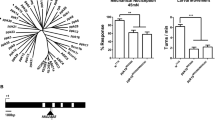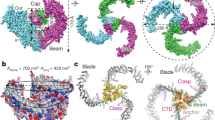Abstract
Transduction of mechanical stimuli by receptor cells is essential for senses such as hearing, touch and pain1,2,3,4. Ion channels have a role in neuronal mechanotransduction in invertebrates1; however, functional conservation of these ion channels in mammalian mechanotransduction is not observed. For example, no mechanoreceptor potential C (NOMPC), a member of transient receptor potential (TRP) ion channel family, acts as a mechanotransducer in Drosophila melanogaster5 and Caenorhabditis elegans6,7; however, it has no orthologues in mammals. Degenerin/epithelial sodium channel (DEG/ENaC) family members are mechanotransducers in C. elegans8 and potentially in D. melanogaster9; however, a direct role of its mammalian homologues in sensing mechanical force has not been shown. Recently, Piezo1 (also known as Fam38a) and Piezo2 (also known as Fam38b) were identified as components of mechanically activated channels in mammals10. The Piezo family are evolutionarily conserved transmembrane proteins. It is unknown whether they function in mechanical sensing in vivo and, if they do, which mechanosensory modalities they mediate. Here we study the physiological role of the single Piezo member in D. melanogaster (Dmpiezo; also known as CG8486). Dmpiezo expression in human cells induces mechanically activated currents, similar to its mammalian counterparts11. Behavioural responses to noxious mechanical stimuli were severely reduced in Dmpiezo knockout larvae, whereas responses to another noxious stimulus or touch were not affected. Knocking down Dmpiezo in sensory neurons that mediate nociception and express the DEG/ENaC ion channel pickpocket (ppk) was sufficient to impair responses to noxious mechanical stimuli. Furthermore, expression of Dmpiezo in these same neurons rescued the phenotype of the constitutive Dmpiezo knockout larvae. Accordingly, electrophysiological recordings from ppk-positive neurons revealed a Dmpiezo-dependent, mechanically activated current. Finally, we found that Dmpiezo and ppk function in parallel pathways in ppk-positive cells, and that mechanical nociception is abolished in the absence of both channels. These data demonstrate the physiological relevance of the Piezo family in mechanotransduction in vivo, supporting a role of Piezo proteins in mechanosensory nociception.
This is a preview of subscription content, access via your institution
Access options
Subscribe to this journal
Receive 51 print issues and online access
$199.00 per year
only $3.90 per issue
Buy this article
- Purchase on Springer Link
- Instant access to full article PDF
Prices may be subject to local taxes which are calculated during checkout




Similar content being viewed by others
References
Chalfie, M. Neurosensory mechanotransduction. Nature Rev. Mol. Cell Biol. 10, 44–52 (2009)
Tsunozaki, M. & Bautista, D. M. Mammalian somatosensory mechanotransduction. Curr. Opin. Neurobiol. 19, 362–369 (2009)
Gillespie, P. G. & Muller, U. Mechanotransduction by hair cells: models, molecules, and mechanisms. Cell 139, 33–44 (2009)
Delmas, P., Hao, J. & Rodat-Despoix, L. Molecular mechanisms of mechanotransduction in mammalian sensory neurons. Nature Rev. Neurosci. 12, 139–153 (2011)
Walker, R. G., Willingham, A. T. & Zuker, C. S. A Drosophila mechanosensory transduction channel. Science 287, 2229–2234 (2000)
Li, W., Feng, Z., Sternberg, P. W. & Xu, X. Z. S. A C. elegans stretch receptor neuron revealed by a mechanosensitive TRP channel homologue. Nature 440, 684–687 (2006)
Kang, L., Gao, J., Schafer, W. R., Xie, Z. & Xu, X. Z. S. C. elegans TRP family protein TRP-4 is a pore-forming subunit of a native mechanotransduction channel. Neuron 67, 381–391 (2010)
O’Hagan, R., Chalfie, M. & Goodman, M. B. The MEC-4 DEG/ENaC channel of Caenorhabditis elegans touch receptor neurons transduces mechanical signals. Nature Neurosci. 8, 43–50 (2005)
Zhong, L., Hwang, R. Y. & Tracey, W. D. Pickpocket is a DEG/ENaC protein required for mechanical nociception in Drosophila larvae. Curr. Biol. 20, 429–434 (2010)
Coste, B. et al. Piezo1 and Piezo2 are essential components of distinct mechanically activated cation channels. Science 330, 55–60 (2010)
Coste, B. et al. Piezo proteins are pore-forming subunits of mechanically activated channels. Nature 483,http://dx.doi.org/10.1038/nature10812 (this issue)
Kim, J. et al. A TRPV family ion channel required for hearing in Drosophila. Nature 424, 81–84 (2003)
Gong, Z. et al. Two interdependent TRPV channel subunits, Inactive and Nanchung, mediate hearing in Drosophila. J. Neurosci. 24, 9059–9066 (2004)
Tracey, W. D., Jr, Wilson, R. I., Laurent, G. & Benzer, S. painless, a Drosophila gene essential for nociception. Cell 113, 261–273 (2003)
Parks, A. L. et al. Systematic generation of high-resolution deletion coverage of the Drosophila melanogaster genome. Nature Genet. 36, 288–292 (2004)
Hwang, R. Y. et al. Nociceptive neurons protect Drosophila larvae from parasitoid wasps. Curr. Biol. 17, 2105–2116 (2007)
Kernan, M., Cowan, D. & Zuker, C. Genetic dissection of mechanosensory transduction: mechanoreception-defective mutations of Drosophila. Neuron 12, 1195–1206 (1994)
Caldwell, J. C., Miller, M. M., Wing, S., Soll, D. R. & Eberl, D. F. Dynamic analysis of larval locomotion in Drosophila chordotonal organ mutants. Proc. Natl Acad. Sci. USA 100, 16053–16058 (2003)
Adams, C. M. et al. Ripped Pocket and Pickpocket, novel Drosophila DEG/ENaC subunits expressed in early development and in mechanosensory neurons. J. Cell Biol. 140, 143–152 (1998)
Ainsley, J. A. et al. Enhanced locomotion caused by loss of the Drosophila DEG/ENaC protein Pickpocket1. Curr. Biol. 13, 1557–1563 (2003)
Xiang, Y. et al. Light-avoidance-mediating photoreceptors tile the Drosophila larval body wall. Nature 468, 921–926 (2010)
Grueber, W. B., Ye, B., Moore, A. W., Jan, L. Y. & Jan, Y. N. Dendrites of distinct classes of Drosophila sensory neurons show different capacities for homotypic repulsion. Curr. Biol. 13, 618–626 (2003)
Acknowledgements
We thank Y. N. Jan of the University of California San Francisco for providing ppk-EGFP5. Research was support by the National Institutes of Health and Novartis Research Foundation. S.E.K. and A.C. are supported by the Skaggs Institute.
Author information
Authors and Affiliations
Contributions
S.E.K. conducted most experiments. B. Coste performed the electrophysiology experiments shown in Fig. 3 and Supplementary Fig. 5. A.C. performed the fly electrophysiology experiments shown in Supplementary Fig. 4. S.E.K., A.P. and B. Cook designed experiments and wrote the manuscript.
Corresponding authors
Ethics declarations
Competing interests
The authors declare no competing financial interests.
Supplementary information
Supplementary Figures
This file contains Supplementary Figures 1-6 with legends and an additional reference. (PDF 940 kb)
Rights and permissions
About this article
Cite this article
Kim, S., Coste, B., Chadha, A. et al. The role of Drosophila Piezo in mechanical nociception. Nature 483, 209–212 (2012). https://doi.org/10.1038/nature10801
Received:
Accepted:
Published:
Issue Date:
DOI: https://doi.org/10.1038/nature10801
This article is cited by
-
Genome-wide association in Drosophila identifies a role for Piezo and Proc-R in sleep latency
Scientific Reports (2024)
-
Piezo2 regulates colonic mechanical sensitivity in a sex specific manner in mice
Nature Communications (2023)
-
A positive mechanobiological feedback loop controls bistable switching of cardiac fibroblast phenotype
Cell Discovery (2022)
-
Drosophila ppk19 encodes a proton-gated and mechanosensitive ion channel
Scientific Reports (2022)
-
Piezo1-expressing vocal fold epithelia modulate remodeling via effects on self-renewal and cytokeratin differentiation
Cellular and Molecular Life Sciences (2022)
Comments
By submitting a comment you agree to abide by our Terms and Community Guidelines. If you find something abusive or that does not comply with our terms or guidelines please flag it as inappropriate.



